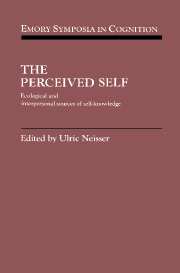Book contents
- Frontmatter
- Contents
- Preface
- List of contributors
- Part I Introduction
- Part II The concept of an ecological self
- Part III The interpersonal self and its implications
- 8 The self born in intersubjectivity: The psychology of an infant communicating
- 9 On the interpersonal origins of self-concept
- 10 Infants' knowledge of self, other, and relationship
- 11 The role of feelings for an interpersonal self
- 12 Spontaneous communication and the foundation of the interpersonal self
- 13 Autism, affordances, and the self
- 14 Through feeling and sight to self and symbol
- 15 G. H. Mead and Martin Buber on the interpersonal self
- 16 Cognitive science, other minds, and the philosophy of dialogue
- Author index
- Subject index
15 - G. H. Mead and Martin Buber on the interpersonal self
Published online by Cambridge University Press: 29 March 2010
- Frontmatter
- Contents
- Preface
- List of contributors
- Part I Introduction
- Part II The concept of an ecological self
- Part III The interpersonal self and its implications
- 8 The self born in intersubjectivity: The psychology of an infant communicating
- 9 On the interpersonal origins of self-concept
- 10 Infants' knowledge of self, other, and relationship
- 11 The role of feelings for an interpersonal self
- 12 Spontaneous communication and the foundation of the interpersonal self
- 13 Autism, affordances, and the self
- 14 Through feeling and sight to self and symbol
- 15 G. H. Mead and Martin Buber on the interpersonal self
- 16 Cognitive science, other minds, and the philosophy of dialogue
- Author index
- Subject index
Summary
This volume is devoted to Ulric Neisser's first two kinds of self-knowledge: ecological and interpersonal. My focus here is on the second of these, interpersonal knowledge. Pertinent writings by G. H. Mead and Martin Buber will be considered, then, in terms of how their writings contribute to, or differ from, Neisser's view (1988; see also this volume). At the risk of some redundancy, I begin by summarizing the main features of Neisser's account of the interpersonal self (1988, pp. 41-46).
Neisser opens by stating that this self is “engaged in immediate unreflective social interaction with another person.” When the actions of one person “mesh appropriately” with the actions of another, they create an occasion of intersubjectivity. This mutuality can be perceived both by the external observer and by the participants. Direct perception rather than inference is the basis of this mutuality or intersubjectivity. As studies of infants indicate, the interpersonal self is specifically oriented by and through expressive gestures; communication through gestures develops the interpersonal self. This process is “an emotional business: the two partners are obviously sharing an affect” (p. 44).
- Type
- Chapter
- Information
- The Perceived SelfEcological and Interpersonal Sources of Self Knowledge, pp. 280 - 289Publisher: Cambridge University PressPrint publication year: 1994



